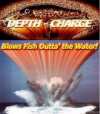Zooplankton Triggers Everything!
When it comes to fish position and activity levels, zooplankton–tiniest of underwater animals–move mountains with their daily up and down migrations. More on the details as we go, but if you’ve ever wondered why the fishing can be so good early and late in the day, Dave Genz says it’s all because of zooplankton.
For years, Genz dealt with the fact that his Vexilar display filled with dancing flickers during the prime time evening and early morning bites, sometimes blindly jigging in the mass of writhing sonar signals and waiting for a thunk of a bite–which came soon enough in most cases.
How and Why of Prime Times
On most days, on most waters, there are two distinct prime times: sunrise and sunset. These periods of rapidly changing light levels appear to be the cause of ‘vertical migration’ of zooplankton. These teeny-tiny animals make a variety of movements, but the dominant one is upward at dusk (eventually to, or near, the surface) and downward near dawn.
When the water fills with this microscopic life, that triggers increased activity in everything from burrowing insects to fish of all sizes. It’s nature’s rush hour. Even at the risk of being eaten by a pike or other predator, panfish move in active pursuit of calories.
This is the time when you can sit tight on a good spot and catch a lot of fish in a few minutes.
Genz has a plausible theory that guides our overall approach.
“When the zooplankton begin moving upward around sunset,” he says, “they’re concentrated within a few feet of the bottom. Because they’re so thick (in one depth zone), bluegills and other panfish species can feed efficiently by just opening their mouths and swimming.”
After darkness falls and zooplankton continue to rise toward the surface, they’re not as concentrated, ‘stringing out’ like traffic on a rural highway. At this point, Genz thinks, black crappies can still feed efficiently on them, having relatively larger mouths than sunfish, but extremely fine gill rakers suitable for the purpose.
“That explains why you catch crappies through the night sometimes,” says Dave, “but the bluegills quit when it gets dark.”
The Classic Pattern Holds
Study the scientific literature and you’ll see that zooplankton migration is a complex subject full of variables. But in most ‘ice-fishing lakes’ there seems to be this classic pattern of most zooplankton remaining deep in the water column during the day (when light levels are high), either on bottom or suspended at a level where they are hard to see. Then, as sunset approaches, massive swarms (sometimes called patches) of zooplankton rise toward the surface, where they feed on phytoplankton (tiny plants) at night.
Then, when light levels increase as sunrise approaches, zooplankton reverse the migration and move back into deeper water.
Today, we think we know more than ever, and yet it’s still correlation, mainly. We can’t say for certain that zooplankton movements are the cause of panfish location and activity levels. But Genz is perfectly confident saying it.
Connecting All the Dots
In the winter, under a coating of ice, panfish eat mainly zooplankton and a variety of burrowing insects when they can get ‘em. In the winter, pike, walleyes and other large predators eat a lot of panfish, along with other small baitfish.
All creatures develop feeding and evasion strategies that take advantage of peak opportunities. In a nutshell, here’s what seems to drive the whole under-ice routine…
Zooplankton are tiny animals. Phytoplankton are tiny plants. Zooplankton eat phytoplankton. “Planktivorous” fish (panfish) are the major predators of zooplankton.
The prevailing theory is that, over ages of time, zooplankton evolved strategies to hide from predators during daylight hours, then rise to feed on surface clusters of phytoplankton under the cloak of darkness. Most planktivorous fish are sight feeders, requiring decent visibility for efficient eating.
So, the classic daily movements of zooplankton are ‘vertical migrations’ that occur as darkness comes on in the evening and again as light levels increase toward daybreak. As darkness descends in the winter– which happens about the time most of us get off work– masses of zooplankton rise from the bottom and begin a rush hour move to the surface, where they will eat phytoplankton during the night. As it starts to get light toward morning, the zooplankton head down to the bottom again, to hide from the mean old panfish.
Panfish, having their own evolutionary talents, have figured out the schedule and make their move to eat when zooplankton begin rising off bottom in the evening. (Again, more like late afternoon in winter.) Panfish try to avoid being eaten by pike, walleyes and other mean old fish, so they lay low during daylight hours, too. But when zooplankton rise off bottom in massive numbers, while they are still concentrated enough to give panfish gills a shot at raking in mouthfuls at a time, active panfish feeding takes place.
During this peak period, there’s still enough light for panfish to see what they’re doing. Poor little zooplankton rise up just a little too early to be safe. Everything is on the move, which is why you can sit over one good hole and catch a bunch of fish, when you would sit fishless, over that same hole, at other times of day.
At dawn, massive clouds of zooplankton concentrate near bottom again, as they tuck into hiding for the day. Another terrific, but brief, feeding opportunity, and panfish action can be excellent if you know where the fish are going to be and drill holes before it gets light.
This classic scenario plays out day after day, year after year, on lakes across the Ice Belt. Now you know more about why Genz is always talking about drilling a lot of holes and moving during the day, then settling in over a few good holes come prime time.
Note: Dave Genz, known as Mr. Ice Fishing, was the primary driver of the modern ice fishing revolution. He has been enshrined in the National Fresh Water Fishing Hall of Fame and Minnesota Fishing Hall of Fame for his contributions to the sport. For more fishing tips, go to www.davegenz.com. |







